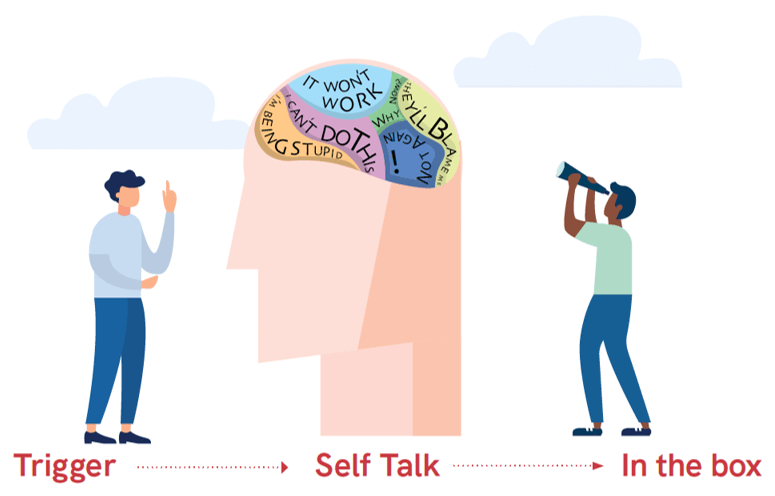How to choose your mindset: One essential practice all leaders need to know
Disruption these days has become such a norm that it’s no longer ‘news.’ This year alone we’ve experienced political and economic unrest across the world, the continual and devastating consequences of global warming, and a pandemic. Leaders today are bombarded with increasingly complex challenges and at times these can feel overwhelming.
But not all leaders are struggling. Some leaders are quietly thriving and others are even flying. So, what are they doing differently?
The answer lies in their mindset.
We may assume that it’s the situation – what is happening around us i.e. our external environment – that is determining whether or not we are at our best on any given day. But in fact, it’s what is going on inside us – our attitude and our mindset – that determines whether or not we are thriving.
We can’t control the external environment but the good news is, we can control how we respond to it. And when we’re able to do that – to master our mindset – we’re far better equipped to lead effectively and courageously.
In this blog post we’ll explore why honing your ability to choose your mindset is so important when it comes to thriving during times of disruption, and we’ll share a simple but powerful technique you can practice, starting today.
Going ‘In the box’ – and getting back out
During heightened moments of disruption, when we are trying to solve seemingly impossible organisational challenges, it’s really natural for us to find ourselves feeling unsettled, anxious, and lacking in self-belief. Our self-talk (the voice in our head that runs a commentary on our life) can easily become critical, pessimistic and judgmental and it is these thoughts that create our experience and feelings when we are not at our best. We describe this experience – when we are not at our best – as going ‘in the box.’
We use the metaphor of a box because our experience in these moments feels similar to going inside a box. We shut down and disconnect. We feel unsafe and may struggle to access our creativity. We are ‘hijacked’ by our own thoughts and are unable to see the reality or possibilities of the situation. We ultimately get knocked off our game, sometimes a little, sometimes a lot.
When we go in the box, we become less aware of ourselves and others around us. Our ability to notice, to listen to others, to be insightful, is hindered. When we are in this state, we are much less likely to have the best quality dialogue with others or make the right choices for our organisation. We all go in the box sometimes, it’s perfectly normal.
The good news is that our mindset, our emotions and our behaviour i.e. the experience we have of a situation, is entirely under our influence. We’re in charge and we can choose a different attitude. The leaders who are deftly leading their organisations through disruption are not the ones with all the answers or all the expertise. Rather, they are the ones who have figured out how to choose their state and be at their best – ‘out of the box’ – more of the time.

How to choose your mindset – the E.T.C technique
So, we know that choosing our state of mind is the key to success, although it’s often easier said than done! But like anything else, we can get there with practice.
That’s where E.T.C comes in. Emotion. Truth. Choice. E.T.C is a technique you can use to get yourself out of the box and bring yourself back to a more grounded and resourceful place. When we are triggered for example by some bad news, or an email, or a look someone gives us, our self-talk can start to kick in. We may tell ourselves exaggerated stories of what is happening around us. Perhaps we imagine the worst-case scenario for the future, or we become critical of a project, or we worry about what people think of us. Self-talk is almost always dramatic and exaggerated. At the heart of the E.T.C practice is our ability to notice these thoughts and feelings, pause, bring ourselves back to the present reality and tell ourselves the truth.
It involves three steps:
1. Emotion
Notice what you are feeling, physically and emotionally. When you have been triggered, the first clue is often a physiological change in your state. You might notice your heart rate increase, butterflies in your stomach, sweaty palms. Then ask yourself what are you thinking and what are you feeling? What is your mind saying about you, others, or the situation?
It’s very important to acknowledge your ‘in-the-box’ state. Sometimes just telling yourself ‘I’m anxious’ can be enough to start to rebalance. Make a mental note of what you’re telling yourself. Perhaps even write some of these dramatic self-talk statements down e.g. ‘I’m not good enough’ or ‘this is never going to work.’
Now breathe. The full stops in E.T.C are very important. They are to remind you to breathe!
When we are triggered, we can stop breathing. If that sounds crazy, pay attention the next time you are triggered and notice how hard it becomes to take slow, deep breaths.
2. Truth
Now’s the time to counter this self-talk and tell yourself the truth. By establishing what’s really true, we can find steadier ground.
To help you get your mind back to a more resourceful place, think of a time when you were at your best, a time when things were going well, when you were energised and motivated. How did you feel in that moment? What were you saying to yourself? Notice the voice in your head. It’s a different voice – start to tune into that one.
Now revisit the self-talk statements you noticed in step one. One by one, start to eliminate all the ‘untruths’ that your self-talk is telling you are gospel. Ask yourself ‘is this something I can 100% guarantee is the truth? Undeniably true?’ Chances are, it’s not.
Here are some examples:
- “I’m not good enough.” This is not true; I have faced hard challenges before and succeeded.
- “I’m being stupid and they all know it.” This is not true. I’m just assuming I know what other people are thinking but I haven’t asked, and no one has said I am being stupid.
- “They will blame me.” This is not true. I cannot predict this with certainty. I’m also trying to do my best.
- “There is nothing I can do about this.” This is not true. There are always possibilities and options.
- “I should’ve done this earlier.” Maybe, but I’m human and ‘shoulds’ or ‘could haves’ are not helping me right now.
When you notice much of your self-talk is not strictly true, you can begin to reveal some of the helpful truths to rebalance and come back to a place of reality.
Take some more deep breaths.
3. Choice
Now that you’re in a place of truth-based reality, the third and final step is to explore your choices. What are your options?
From a position of truth, make a conscious choice about what you intend to do or not do. What choices do you see that you didn’t see before? Next time something like this happens, what could you do? Is there something you can resolve now e.g. a conversation you could have? Think of as many choices as you like. We’ve found it’s helpful to have around three.

Choose differently and break the cycle
By choosing to respond differently, you not only bring yourself out of the box, you also begin to break the cycle. So next time you encounter difficult circumstances, and you feel yourself being triggered, give what we’ve described a go. You may just be able to catch yourself earlier, shift your state and get out of the box sooner – then you’ll be able to spend more time being at your best, feeling good and leading brilliantly.
This is one of the key practices we recommend for any leader. If you want to learn about some of the other simple but highly effective practices to thriving during times of disruption, download our free guide: Leading in a crisis: Why do some leaders thrive and others survive?
How to choose your mindset: One essential practice all leaders need to know
by Sophie Ireland

